Fusion happens when two nuclei join together. It’s a process that can release huge amounts of energy — if the reaction can be held together long enough.
The concept of fusion is simple: it’s just two nuclei joining into one. In practice, however, fusion is a difficult task. Such nuclei don’t like fusing.
Inside the nucleus of an atom, you’ll find both protons and neutrons. Hydrogen is the lone exception — most hydrogen atoms have a nucleus with just a single proton. Protons have a positive charge, which means they repel each other, making it extremely difficult to get two nuclei close enough together to fuse.
“You’re trying to get stuff that doesn’t want to get close together really super close,” says Ben Levitt, Vice President of Research and Development at Zap Energy. “So the forces that make those things repel can be overcome by forces that make those things combine.”
At high enough temperatures and pressures, nuclei can get close enough together that a different force takes over. It’s called the strong nuclear force, and it’s what holds protons and neutrons together. It's powerful, but only at very short distances, like you find inside an atom's nucleus. Get two nuclei close enough together, and the two nuclei will fuse into one, causing them to become a different, larger element. Two hydrogens can make a helium. A hydrogen and a helium can make lithium, and so on with other elements.
Fusion on Earth
Fusion reactions power stars, but they don’t typically happen on Earth. The extreme conditions necessary for fusion to happen — pressures and temperatures of 10 million degrees Fahrenheit or more — just don’t exist on our planet.
But it’s possible to recreate these intense conditions with specially made devices. Since the 1950s, scientists have been recreating the conditions inside stars with machines that use strong magnetic fields, electrical currents, powerful lasers and more. These experiments attempt to hold plasma — a state of matter with properties of both a liquid and a gas — steady while heating it to the extremely high temperatures needed to kickstart fusion. Several experiments have succeeded in sparking short-lived fusion reactions.
Yet the plasmas that are used to create fusion are challenging to produce, and until last year no fusion devices had sustained even a single fusion plasma that released more energy than was put into it. In December 2022, the National Ignition Facility at the Lawrence Livermore National Laboratory became the first experiment to succeed in holding one in place long enough - with a sufficiently high density and temperature by inputting enough energy into it - to edge past the energy breakeven point known as Q=1.
Those historic results show that fusion works as expected, but because they were driven by power-hungry lasers, the path to a fusion power plant remains uncertain. Breakeven will need to be well surpassed and easily repeated to make this approach to fusion energy viable.
The history of fusion research over the past half-century suggests that alternative approaches are needed, says Benj Conway, Zap Energy's Cofounder and President.
"It's time to think differently about these challenges, and find a better path forward,” he says.
Zap Energy's fusion devices bypass the need for superconducting magnets or high-powered lasers. A technique known as a sheared-flow-stabilized Z pinch keeps the hot, dense plasma stable so that fusion can happen efficiently and repeatedly.
How fusion makes energy
When two atoms fuse, the new element they create actually has a little less mass than the sum of its constituent parts. That’s because some of the mass of a fusion reaction is ejected in the form of energy given to the fusion products.
Zap Energy fuels its fusion cores today with deuterium, a hydrogen isotope that has one neutron in addition to a proton. In the future, the company’s cores will fuse deuterium with tritium – another hydrogen isotope – which has two neutrons and a proton. The reaction combining the two creates a charged helium nucleus, also called an alpha particle, as well as an energetic neutron. Each reaction produces 17.6 megaelectronvolts of energy – the equivalent of over 10 million chemical reactions. Some 80 percent of this energy is given to the neutron, while the rest is in the alpha particle.

“The idea is to use the extra energy that comes off of these collisions, capture it and put it on the grid,” says Hannah Meek, a research engineer at Zap Energy.
In a Zap core, these supercharged fusion products will be absorbed by a wall of liquified lead-lithium metal, bouncing from nuclei to nuclei and heating them up. From there, the process looks similar to any other power plant: The heat is converted to steam, the steam is captured by turbines and the turbine spinning is converted to power on the grid. Put together inside a working power plant, this process could meet humanity’s energy needs with safe, clean power.
“Time is of the essence commercially, but time is also of essence to the planet,” Conway says. “Fusion energy needs to be achieved as soon as possible.”

